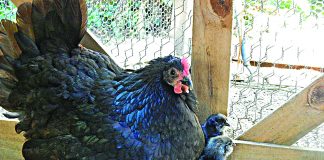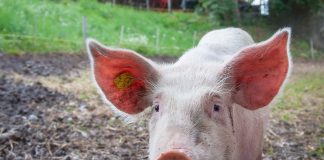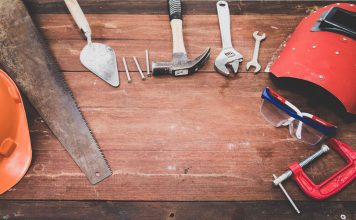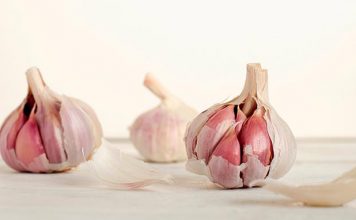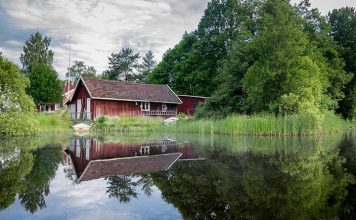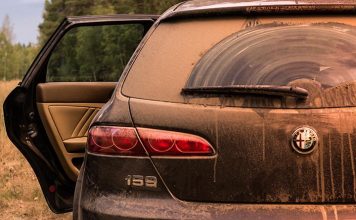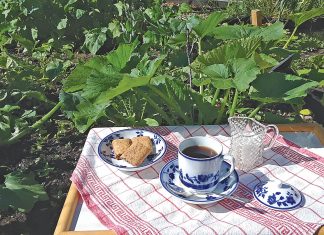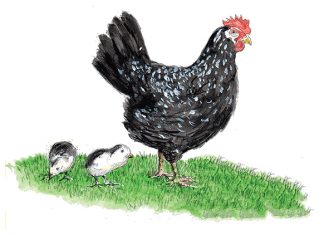| Issue #124 • July/August, 2010 |
In February of 1996 my husband, Kevin, two-year-old daughter, Kayla, and I moved from New Jersey to Maine. Our goal was to find a farmhouse with substantial acreage of field and woods. Our main search was in the midcoast area of Maine. Since my husband was going to be a self-employed carpenter, we sought an area that was growing economically and had plenty of tourists.
|
After utilizing many realtors, we accidentally found our diamond in the rough ourselves. It was an 1800s-era German-style stucco cape with a large field and forty acres of mixed woods. My second child, Kenny, was born on May 7, 1996 and a couple of weeks later we moved in.
Renovations
As expected with old houses, we needed to do a lot of renovations. A new roof and windows were the first items to be addressed. Then the three chimney flues needed to be relined, and we installed a wood stove in a fireplace.
We were very fortunate that all of the original floors except the kitchen remained, and the window trim and three original fireplaces were intact. Two of the fireplaces are in bedrooms, and it is such a treat to enjoy their glow in the wintertime and cook toast or stew in them.
The kitchen came with a wood cookstove that I use from October till March for cooking, heating, melting beeswax for candles I sell, and boiling maple syrup that we tap. This stove has been indispensable in our homesteading life.
|
The first year was very difficult doing renovations with a two year old and a newborn. We were very fortunate to have my husband’s father and grandmother stay with us for weeks at a time to help us with the renovations. Kevin’s grandmother would help me with the little ones while I was away sanding or painting. We had to take many precautions while renovating due to the lead paint on the window trims. I was constantly changing clothes when I had to nurse the baby. During the renovation my husband’s father, grandmother, myself, and our two children slept in a small bedroom together. My husband slept on a cot in the hallway so that everyone else would have the beds. We gutted most of the house except the kitchen and the bedrooms downstairs. We basically lived out of two rooms and hung blankets in doorways to help with the dust. My husband’s grandmother has since died, but I will always cherish her wisdom and help during those tough times.
|
My husband learned masonry skills since our house is constructed with two layers of brick and then stucco over that. We had to rent a sand blaster to remove the old stucco, and then hundreds of bricks needed to be replaced before the new stucco was applied. We only did one side of the house each year because of time and money.
Probably the worst experience we encountered while renovating was the discovery of carpenter ants. One day while in the kitchen I heard a munching sound and thought maybe it was a mouse. I ended up following the noise to a kitchen beam, but didn’t see anything. I alerted my husband who knocked on the beam with his fist. To our surprise, millions of ants came rushing out all over the place. The lucky part of the story was that the nest was right there with the queen and the larvae. As a result, we took the nest and destroyed it. We haven’t seen an ant since and we didn’t have to use chemicals to get rid of them.
|
The next couple of years we worked on getting the house more insulated, building up Kevin’s carpentry business, and starting a garden.
After the house was tight and habitable, we started on the barn. Again, we started with new windows one year and a new roof the following year, then we replaced the cedar shingle siding on the east side and have been working our way around. This year the final side of the barn should be completed.
The renovation has been slow, but purposeful since we do all the work ourselves. When I look at the pictures from the past years I feel exhausted but proud. In the 12 years we have been renovating, we have had two more children, Kane and Kennedy. Even though the renovations were difficult to do with children, and while still trying to earn an income, it was worth saving a piece of history. We will still have some things to do, but the major projects are out of the way, including the well and septic, so it is all downhill from here.
The man that owned the house before us had the house registered with the National Historical Society. My children enjoy living in our historical house; they love reading about when it was used as a Methodist meeting house and visiting the cemetery next to us to get a sense of the former inhabitants that are buried there.
|
Learning to homestead
The first winter Kevin did not have much work, so we cut pine off our land and sold it to paper mills. The next summer we opened a driving range that we ran for seven years. The driving range gave some extra income, but was not lucrative enough with all the time we put into it, and it didn’t bring us joy. Instead, we use the field for livestock now. We have chickens and sheep and we raise two pigs every year. Last year my daughter won a Beltie cow from a 4-H essay contest.
I try to really cut costs and save money whenever possible. For 12 years I have not had a dryer. I use drying racks in winter and hang my clothes outside in the summer. Our only source of heat is our wood stoves, and we cut all of our own wood ourselves. We each wear several hats on our homestead, like me being the family barber, and my husband being the butcher.
We waste nothing. Manure is a precious fertilizer and wool from the sheep is used for felting and knitting projects. The skirted wool is used to mulch gardens and looks very pretty. Apple drops, Jerusalem artichokes, and garden waste all help fatten the pigs. We sometimes render intestinal fat from the pigs to make soap.
During turkey and deer season my husband and older son, Kenny, hunt to help fill the freezer. Other homesteading tasks we perform include saving seeds and making tea, shampoo, and bee balm. My husband builds furniture, stone walls, and fences. We had our first honey harvest from our bees last year, and we also planted peanuts, loofah sponge plants, and broomcorn for the first time. We recently inoculated logs so we can grow shiitake mushrooms. Through the years we have sold Christmas trees from our land, made wreaths, and cut weather sticks. My favorite planting has been our Reliance peach trees.
|
Open house and workshops
Our first open house took place last fall, and we sold products we make from our homestead. It was successful and very exciting for us. We have just completed a medicine wheel garden which we will use for our educational tours.
We have been hosting adult workshops on woodstove cookery, spinning, and other tasks we perform on our homestead. Several schools have visited our homestead for field trips and this summer we held a children’s camp that taught kids about bees, chickens, sheep, and cows. At the camp children also made items from the homestead, such as herbal wreaths, lavender wands, pressed flower bookmarks, beeswax candles, garden signs, and iris leaf paper. This was an amazing experience for our family and also a help to our income.
|
Involving children
I feel so blessed to raise my children in an atmosphere where they don’t want to watch television or play video games. Instead you might find my children making fly ties from deer fur, picking blueberries, felting a handbag from our sheep’s wool, or mixing up an economical batch of homemade laundry detergent that doesn’t contain bleach or ammonia. Kayla is especially inspired by our homesteading ways and has always been passionate about writing in our home school. As a result, she had a home schooling column this past year with our local paper, The Lincoln County News. The editor is allowing her to write articles on homesteading, too.
This year my children have made spatulas, hammocks, and oars. Just recently my two older children have tried their hand at blacksmithing at our local historical society. They participate in the Youth Enterprise Zone at The Common Ground Fair which is hosted by Maine’s Organic Farmers and Gardeners Association (www.mofga.org). At this event they can sell their homemade products to earn some income for themselves.
|
Kayla and Kenny also work at the dairy farm down the road, milking cows three nights a week, which is a help to our income so they can purchase some books or clothes they might need.
We may never be rich with money, but we derive great satisfaction from working our land and trying to be stewards of the earth.
When we get visitors they are amazed at the work we’ve done including the vegetable, herb, and flower gardens. However, we do get some comments from visitors on our lifestyle, such as, “Why on earth would you want a small three bedroom cape with four children?” Many people thought we were crazy when we moved out into the country and didn’t think we would survive. I just tell people that instead of cleaning a 2000 plus square foot home I would rather spend time on my acreage producing food from it. Our family doesn’t measure success with excess. We realize how rewarding our life is when we sit down to eat a chicken we’ve raised and vegetables we’ve grown.
We still have so many aspirations but each season we try to increase our homesteading ventures and hopefully become more self sufficient. As the saying goes in Maine, “It’s not what you do, but how many things you do to make a living.” We feel like we have always belonged here, and found our true home where people are resourceful.











